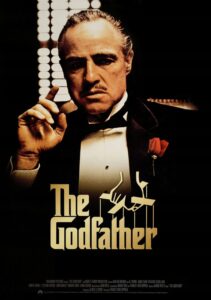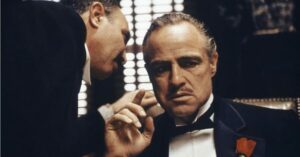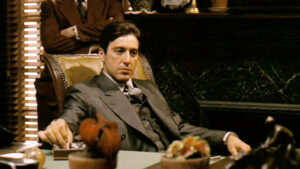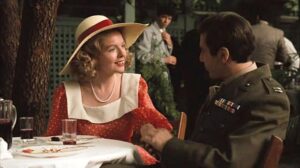“The Godfather” – a Masterpiece of Gangster Cinema

Title: “The Godfather”
Release Date: 1972, 1974, 1990
Director: Francis Ford Coppola
Cast: Marlon Brando, Al Pacino, Robert Duvall, James Caan, Talia Shire, Diane Keaton, Richard S. Castellano, Robert De Niro, John Cazale, Andy Garcia, Sofia Coppola, Eli Wallach
Mario Puzo and Francis Ford Coppola’s trilogy about the Italian Corleone family is a masterpiece of its genre. It is as much the story of a great individual as it is of a family and the transformations taking place across America.
“The Godfather” was made in 1972 and almost immediately captured the hearts of audiences and critics alike. The film is a quintessential gangster movie, and at the same time a multi-layered work that reflects, as if in a mirror, not only the image of Italian emigration, but also the general social situation in the United States. The brilliantly constructed story of the Corleone family (and mafia at the same time) revolves around the protoplast of the family – don Vito (played by phenomenal Marlon Brando) and his sons’ struggle to maintain their position in the dark world. The film won three Academy Awards – for Best Picture, Best Actor (Marlon Brando) and Best Screenplay.
What is interesting, the sequel to “The Godfather II”, although not much better than the first one, has already received six Oscars, including one for Best Supporting Actor for Robert De Niro. He played the role of young Don Vito Corleone, climbing the gangster ladder. In 1990 the third part was made, presenting the fate of the aging Michael Corleone (Al Pacino) and his struggle for the legality of mafia business.
“The Godfather” – Coppola’s mastery of film construction

One of the most distinctive features of “The Godfather” trilogy is its narrative ingenuity. It relies on a precisely planned course of action – each part begins with a momentous family-religious celebration and ends with a bloody massacre. “The Godfather” opens with the famous wedding scene of don Vito Corleone’s daughter, while it ends with Michael’s cruel showdown with the heads of other mafia clans.
“Godfather II” begins with the communion ceremony of Michael’s first-born son, and in the finale his brother Fredo is murdered on don Corleone’s orders. The last part of the trilogy begins with a church service during which Corleone receives a Vatican order for his charity work, while the finale shows the scene of Michael’s assassination, which leads to the death of his daughter.
This combination of religion and crime in “The Godfather” is extremely telling. This state of affairs reaches a climax in “The Godfather III”, when the Corleone family does business with the Vatican itself. Furthermore, both of Coppola’s distinguished spheres are heavily tied to family in the film. Religious and family customs are characterized by a terrifying hypocrisy, as dark evil lurks beneath their surface. Of course, baptism itself has a symbolic dimension, it means being marked and belonging to a particular group.

An ingenious and significant structural solution of “The Godfather” is also the introduction of flashbacks in the second and third part of the work. Thanks to the returns to the past, the whole story gains narrative coherence. We go back to the beginning of the 20th century and learn about the dramatic fate of Vito Corleone. As a boy growing up, he loses his entire family in his native Sicily. His father, mother and brother are murdered by a ruthless local mafia boss, and Vito himself manages to escape to the USA. However, America does not turn out to be the expected paradise. The New York environment of Italian immigrants is ruled by the hard law of the strongest, and Vito can support his family only after he liquidates the mafia boss and becomes a godfather himself.
“The Godfather” and the Mafia Family
“The Godfather” accurately depicts the mafia structure called “the family”. At its head is the “godfather”, who has his own legal advisor – consigliere – this role is played by Tom Hagen (Robert Duvall) – Corleone’s adopted son. Lower in the hierarchy are the “soldiers” – people who perform tasks given to them by their superiors. The whole story would not be interesting, however, if it were not for the central character – don Vito Corleone. Marlon Brando has masterfully built the charismatic personality of the “good robber” who evokes genuine admiration and sympathy from the viewer despite his rather demonic function in the criminal world. Don Vito appears to be the quintessential father figure – the mainstay of local justice and guarantor of rights in a world of corrupt politicians and powerless policemen. Family ties are the highest sanctity for the protagonist, and each member of his clan can count on his protection and assistance.
“The Godfather” – a mythical tale of a struggle for succession
“The Godfather” can be read on many different levels. One of them is the mythical story of a prominent father and evil sons fighting among themselves to take over. After an attempt on don Vito’s life – Sonny (James Caan) and Michael (Al Pacino) try to control the crisis situation. When Sonny is killed by members of a rival clan, Michael takes over.

Initially driven by noble ideals, the new godfather quickly becomes the embodiment of ruthlessness and cold calculation. He manages to build a very strong position for his mafia, but on the way he loses his wife Kay (Diane Keaton), and orders the murder of his own brother. In the last part of the trilogy, the aging Michael is already extremely lonely, and the last victim of his activities falls his beloved daughter Mary (Sofia Coppola). Michael Corleone thus embezzles his father’s ideals.
His biggest dream is to clear his family’s name and get out of dark business, but it turns out to be impossible. Once committed, the crime entails a string of other misfortunes. “The Godfather” is thus a fatalistic tale of man’s eternal entanglement in evil. It is no coincidence that no area of the world remains free from it – not even the Vatican itself.
“The Godfather” – Cosa Nostra as a model of corporate America
“The Godfather” is an outstanding film also because of its socio-political aspect. It shows the birth of the Cosa Nostra – a criminal model based on the tradition of the Sicilian mafia, but in practice different from the original. “The Godfather” captures the significant crisis of the Sicilian mafia based on family ties. It could not survive in New York, where the family was overtaken by business and profit from drug trafficking.
Cosa Nostra is the same model of American society. “The Godfather” shows the progressive crisis of the family, which began in the United States in the 1940s. The cause of the destruction of bonds becomes the corporation as the dominant economic element. Interest and success become priorities, to which all spheres of individual life are subordinated. Thus, there is no place for any principles in the new order.
A.Grabicz, “Kino, wehikuł magiczny. Przewodnik osiągnięć filmu fabularnego. Podróż piąta 1974 – 1981”, Kraków 2009.
“Kino epoki nowofalowej”, pod red. T. Lubelskiego, I. Sowińskiej, R. Syski, Kraków 2015.
